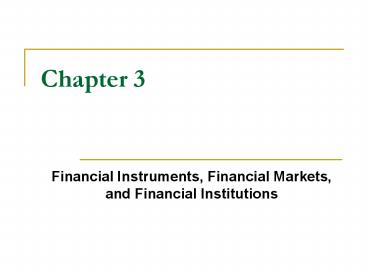Financial Instruments, Financial Markets, and Financial Institutions - PowerPoint PPT Presentation
1 / 28
Title:
Financial Instruments, Financial Markets, and Financial Institutions
Description:
Information: Pool and communication information about. issuers of financial instruments. ... Electronic Communications Network (ECN) ... – PowerPoint PPT presentation
Number of Views:821
Avg rating:3.0/5.0
Title: Financial Instruments, Financial Markets, and Financial Institutions
1
Chapter 3
- Financial Instruments, Financial Markets, and
Financial Institutions
2
The Financial SystemThree Elements
- Financial Instruments
- Financial Markets
- Financial Institutions (intermediaries)
3
Preliminaries Definitions
- Types of Finance
- Indirect Institution stands between lender
and borrower. - Direct Borrowers sell securities directly to
- lenders in the financial
markets - Assets Liabilities
- Asset Something of value that you own
- Liability Something you owe.
4
Funds Flowing throughthe Financial System
5
1.Financial Instruments The things you should
know
- Definition.
- Uses.
- Characteristics.
- Classes.
- What Makes Them Valuable?
6
1.1 Financial Instruments Definition
- A written legal obligation of one party to
transfer something of value, usually money, to
another party at some future date, under certain
conditions.
7
1.2 Financial Instruments Uses
- Means of Payment Purchase goods and services
(ex employees accept -
stock as payment ) - Store of Value Transfer purchasing power into
the future - Transfer of Risk Transfer risk to from one
person to another
8
Financial Instruments Examples
- Primarily Used as Stores of Value
- Bank Loans
- Bonds
- Home Mortgages
- Stocks
- Asset-backed securities
9
Financial Instruments Examples
- Primarily used to Transfer Risk
- Insurance Contracts
- Futures Contracts
- Options
10
1.3 Financial Instruments Characteristics
- Standardization Overcome the costs of complexity
- Makes them easier to understand
- Communicate Information Summarize essential
information about issuer Eliminate expense of
collecting information
11
1.4 Financial Instruments Classes
- Underlying Used to transfer resources
Examples stocks and bonds (Ch8 Ch6) - Derivative Value derived from underlying
instruments Examples Futures and options (Ch.
9)
12
1.5 Financial InstrumentsWhat Makes Them
Valuable?
- Size of the payment Larger ? more valuable
- Timing of payment Sooner ? more valuable
- 3. Likelihood payment is made More likely ?
more valuable - 4. Conditions under with payment is made When
you need it most ? more valuable
13
2. Financial Markets The things you should know
- Definition.
- Roles.
- Structures
- Characteristics.
14
2.1 Financial Markets Definition
- Places where financial instruments are
bought and sold.
15
2.2 Financial Markets Roles
- Liquidity Ensure owners can buy and sell
financial instruments cheaply. - Information Pool and communication information
about issuers of financial instruments. - Risk sharing Provide individuals a place to
buy and sell risk.
16
2.3 Financial Market StructurePrimary vs.
Secondary
- Primary Buy and Sell Newly Issued Securities
- Secondary
- Trade Existing Securities
17
Financial Market StructureCentralized, OTC, and
ECNs
- Centralized Exchange
- Physical location where trading takes place
- Over-the-Counter Market (OTC)
- Networks of dealers connected
electronicallyElectronic Communications Network
(ECN) - Electronic networks where buyers and sellers
interact directly.
18
Financial Market StructureDebt, Equity, and
Derivatives
- Debt and Equity Markets Financial claims are
bought and sold for immediate cash payment - Derivative Markets
- Financial claims based on underlying
instruments are bought and sold for payment at
a future date
19
2.4 Financial Markets Characteristics
- Well functioning markets have
- Low transaction costs
- Communicate accurate information
- Protect Investors
20
- Placing an order
- Stock you wish to trade
- Buy or sell
- Size of order
- Price
21
- Investors provide capital when they know they can
get it back. - Disparities in investor protection help explain
differences in financial development. - Without investor protection a countrys financial
system does not develop. - This hampers growth.
22
3. Financial Institutions The things you
should know
- Definition.
- Roles.
- Structures
23
3.1 Financial Institutions Definition
- Financial institutions (intermediaries) are the
firms that provides access to the financial
markets both to savers and to borrowers.
24
3.2 Financial Institutions Their Role
- Reduce transactions cost by specializing in the
issuance of standardized securities - Reduce information costs of screening and
monitoring borrowers. - Issue short term liabilities and purchase
long-term loans.
25
Flow of Funds throughFinancial Institutions
26
Financial InstitutionsA Simplified Balance Sheet
27
Financial Industry Structure I
- Depository Institutions Take deposits and make
loans - Insurance Companies Accept premiums, pay out
based on events - Pension Funds Invest contributions, provide
payments to retirees
28
Financial Industry Structure II
- 4. Security Firms Proved access to financial
markets - 5. Finance Companies Raise funds in financial
markets, make loans - 6. Government Sponsored Enterprises Raise
funds in financial markets, make loans,
provide guarantees.

